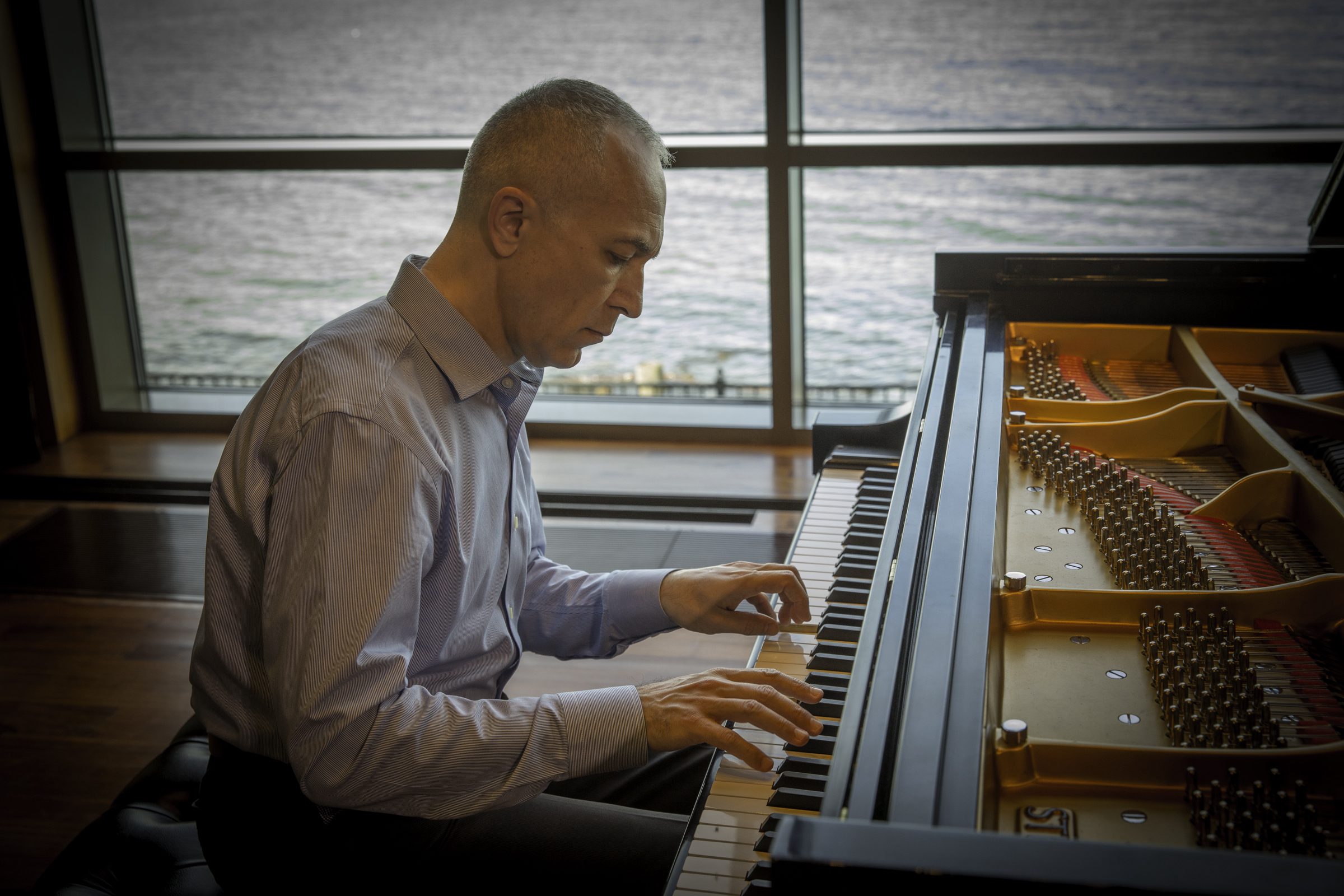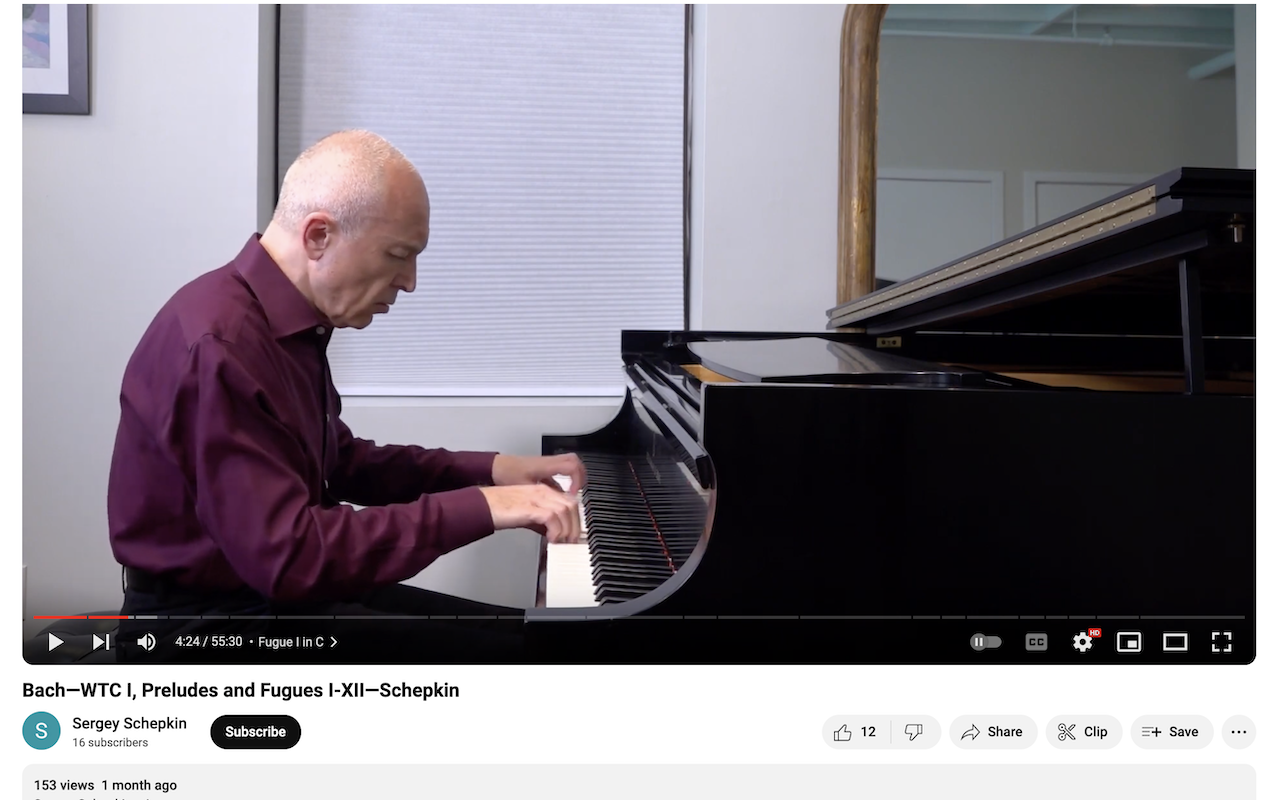The Greatest Concert Pianist You've Maybe Never Heard Of?
Sergey Shepkin's At-Home Bach WTC Videos
[Note: “Playback on other websites has been disabled by the video owner.” Therefore, to open up this YouTube video in another window, please click HERE.]
In 1973, Joni Mitchell wrote the song “A Free Man in Paris,” which, at the time, I found somewhat confusing. The confusion remained until I later learned that Mitchell had written the lyrics from the perspective of her friend David Geffen, the legendary music agent and promoter. So, it was not Joni herself who was saying that when she was in Paris, she had no one’s future to decide. Joni wished to convey that when David Geffen was in Paris, he had no one’s future to decide.
In the song, Geffen’s character says that he would stay in Paris, except for the work he had taken on back in Los Angeles, “stoking the star-maker machinery behind the popular song.” And with that, a new catchphrase entered the English language; either as “star-maker machinery” (I hyphenate it because it is a compound modifier) or “star-making machinery.” There is even a nonfiction book by Geoffrey Stokes about the music business in the 1970s that is titled Star-Making Machinery: Inside the Business of Rock and Roll.
The Star-Making Machinery has never confined its workings to rock or pop music. Classical music and opera have been at least as afflicted by it as pop and rock. There was Luciano Pavarotti, and then there was everyone else. There is Itzhak Perlman, and then there is everybody else. There is Yo-Yo Ma, and then there is everybody else. There are Lang Lang and Yuja Wang, and then there is everybody else.
At least, that is from the standpoint of people who get their information about classical music from mass (albeit mostly upscale) media (such as National Public Radio, the New Yorker, the New York Times, and even People magazine) rather than from the classical-specialist magazines such as BBC Music, Gramophone, American Record Guide, and Fanfare.
The relevance being that the unavoidable consequence of Star-Making Machinery is, so to speak, that the rich get richer, and the comparatively unheralded in the mass media remain comparatively unheralded in the mass media. Hence the headline, “The Greatest Concert Pianist You've Maybe Never Heard Of?”
Sergey Schepkin has not been living in a cave, like Zarathustra. Indeed, Dr. Schepkin’s Steinway & Sons Recordings releases have received rapturous reviews from the likes of Gramophone, American Record Guide, and Fanfare. But perhaps it is the case that his place in the ecosystem is more of “a pianist’s pianist” than as a household name, especially in households that don’t listen to a lot of classical music.
So, if this is your first exposure to Sergey Schepkin, I think you are in for a real treat. And if you are already aware of his Steinway and Ongaku recordings, I also think that you are in for a real treat, that being his new at-home live video recordings of all 24 Preludes and Fugues of Book 1 of Bach’s Well-Tempered Clavier. Be sure to share the links with any piano students in your life!
Bach’s first Prelude from Book 1 of the Well-Tempered Clavier (in C major) certainly is one of the most recognizable pieces of classical music, period. It is not only one of the “bedrock” (by which I mean basic or elementary) keyboard pieces; it also ports over very naturally to fretted plucked strings such as the lute, or the Spanish or Classical guitar.
(I find it noteworthy that for her breakthrough 1968 Moog synthesizer LP Switched-On Bach, Wendy Carlos did not go for the major-key Prelude 1, but rather the minor-key Prelude 2. Switched-On Bach, by the way, continuously occupied the top spot on the Billboard Classical Albums chart from 1969 to 1972.)
The first observation I want to make is that, to a rather high degree, Prelude 1 is deceptively simple. Bach creates a gentle cascade of rippling arpeggios that has been compared to a mountain stream. (Bach’s family name is the German word for “Brook,” but I think that that is only a coincidence.)
However, below the surface, so to speak, there is a degree of rhythmic tension (or at least, opportunities for a player of subtlety to create rhythmic tension), and some refined harmonic surprises. Perhaps, when Bach included both G-sharp and A-flat in the same piece, he chuckled to himself, “Let’s see if anyone notices that!”
The second observation I want to make is that the term “Prelude” itself is one of those paradoxes that are so familiar to us that we gloss over the fact that it is, in reality, a paradox. When I was a young music student, I thought it rather curious that the literal meaning of “Prelude” is “Before Playing.”
However, every time one plays a Prelude—well, Duuh, one already is playing.
Now, of course, one way to look at it is that a Prelude is a warm-up, a curtain-raiser, or a less-consequential piece to play before a more-consequential piece, such as a Fugue. Gottit. But there is a more interesting aspect to the origin of the term. In France, before playing their program, a lutenist would play arpeggios in several keys, to check the pitch accuracy of his or her lute’s tuning.
Someone (or perhaps more than one person) then realized that what had started out as a method to check tuning could become the basis of a musical genre. I can think of one Wieniawski violin showpiece that starts out by sounding as though the violinist is tuning up (“Obertass et Dudziarz / Le Ménétrier”). There’s also Toshiko Akiyoshi’s charming big-band chart “Tuning Up.”
Anyway, back when John Marks Records/JMR was up and running (and turning a modest profit) by selling CDs the old-fashioned way (via walk-in, brick-and-mortar record stores), I had an interesting conversation with a classical-department manager, at a record-retailers’ conference. He came up to me and said:
John, when you sent me Arturo Delmoni’s Songs My Mother Taught Me, I looked at the track listings and I said to myself, “I need another ‘Méditation’ from Thaïs in my store like I need a hole in my head.” But I dutifully put the CD in the store’s CD player, and… Wow.
I tell that story in the expectation that one or two readers out there might, at this very moment, be saying to themselves, “I need another WTC Prelude 1, like I need a hole in my head.” Well, a very small effort indeed it will be, to click over and to give a listen.
BTW, a welcome feature is that if you “hover” your cursor over the YT video, down at the time line it will tell you which Prelude or Fugue you are listening to. Because in this 55-minute video, Maestro Schepkin plays Preludes and Fugues 1 to 12 from Book 1.
Another way of getting to individual video chapters is to click on “more” in the description of the video. You can then see all the chapters at once, and click on the ones you would like to hear. Preludes and Fugues 13 to 24, the second half of Book 1, can be found HERE.

Sergey Schepkin was born in St. Petersburg, Russia. He studied piano at the St. Petersburg Conservatory, graduating summa cum laude in 1985. After relocating to the United States in 1990, he studied with Russell Sherman at New England Conservatory in Boston, where he earned an Artist Diploma in 1992, and a Doctor of Musical Arts degree in 1999.
A little more than 25 years ago, Schepkin made a big splash playing Bach keyboard works in recital. He also released a series of recordings on the Ongaku label that were met with stellar reviews. The comparisons to the young Glenn Gould were fast and furious.
More recently, Schepkin’s Bach recordings on the Steinway & Sons Recordings label have been met with similar praise. Tant mieux, you can listen to those recordings (and many others) at no charge, via Steinway Streaming:
• Bach: The Six Partitas / Sergey Schepkin
• Bach: The Six French Suites / Sergey Schepkin
If you click on the “Notes and Reviews” tab on the Steinway Streaming album pages (and then, click on “Read more”), you can skim over truly extraordinary praise from the world’s most prestigious magazines and critics. I really ooh’ed and aah’ed over this little gem, from a review of Schepkin’s Partitas:
He stands head and shoulders above more famous pianists like Gould (July/Aug 1994—one of his least satisfying recordings), the prissy Andras Schiff (Nov/Dec 2009), [and] the dutiful Angela Hewitt (no ARG review).
Well! There you have it. Do yourself a favor and click over and listen, and if you like what you hear, please give a thumbs-up, and please leave a comment.
# # #












































.png)








